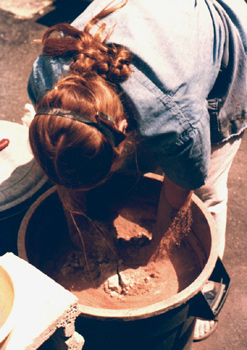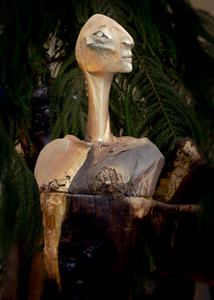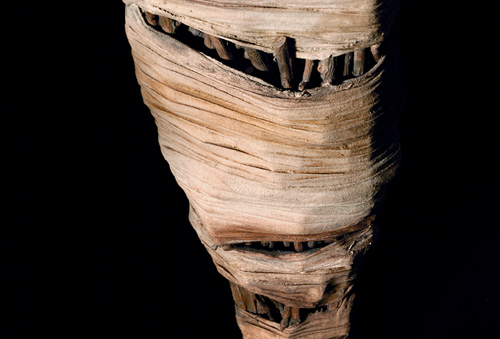| intro | sculpture | drawings | biography | contact |
technical
Clay

Fired stoneware clay is the one constant element. I mix my own clay, by hand; I do not use either a mixer or a pug mill. I value the immediacy of knowing my clay intimately from the early stages of the process. The body is made to a simple formula I have used for over forty years. After the clay is dry mixed and then wet mixed, it is aged for a few weeks as slurry, dried to a soft workable consistency outdoors on plaster slabs, then bagged. My clay is aged for two to five years. By then I have a compliant, reliable, earthy-smelling clay body that is a joy to work with. It is sensitive enough to register a fingerprint, yet stable enough to build well over six feet high. Strong and forgiving in the working, consistent in the drying and firing, this clay has personality that informs the work. The amount and quality of the input provided by the clay cannot be overemphasized.
Occasionally a white stoneware or an earthenware body is required. I use a variety of commercially available clays, often worked and fired directly in conjunction with my own stoneware. All scrap is dried, slaked together, and reused, often producing a clay with a variety of colouration that can enhance the character of the surface.Building
The primary building method that I use is a “large-slab” technique that was used more than two millennia ago by the ancient Etruscans in their life-size ceramic statues and funerary monuments. I have explored this method for nearly fifty years; its possibilities are endless. I do not use a slab roller; I cherish the time spent making slabs as “going inward” time, thinking and planning time. I need this hands-on time to get in touch - literally - with my clay, as it is this day, this moment. In doing the “donkey work”, my preparation for the piece is both physical and mental. I have time to make choices. By making each slab individually I can obtain the moisture content, thickness, air content, compression and surface character I want. These physical factors are my connection to my intention for the piece.
As well, all the traditional handbuilding techniques are utilized where required.
Firing
My stoneware clay matures at cone 5, vitrifies at cone 10. This versatile clay body will accept a huge variety of glazes within this wide firing range. As I have moved into making taller sculptural pieces, and no longer glaze, I fire much lower, at a bisque temperature of around cone 04, (1050 C.) so as to retain the openness of the body. This still porous body is receptive to the colour application I intend for the piece.
Raku
The raku firing process is primal and immediate, rich with variables. When the glaze matures the piece is removed, red hot, from the kiln and placed in a combustible material such as straw. As life marks our faces, the burning material may imprint itself into the molten glaze. The fire is smothered to create a reducing atmosphere; this carbonizes the clay and enhances the metallic lustres characteristic of raku glazes. This is the only process where I still use glazes.
Wrapping
Wrapping, for me, symbolizes attention to the necessities of the soul. Based on Egyptian mummification, (old, worn linen is my preference) this layered wrapping is associated with the creation and protection of a safe place.
Recognition of change and transformation, of death as part of life, creates an awareness of the sweetness of life and of the unique beauty and usefulness of each part of creation. Found objects in conjunction with wrapping delight me with their incongruities and multiple readings.
As in ancient Egypt, old, worn linen is my preference for wrapping. The fabric is impregnated with a durable, permanent, waterproof material. The act of wrapping requires patience; it is a quiet, rhythmic process. I love this peaceful working pace. As linen follows contour, wrapping reveals as much as it covers. For a moment, the invisible may be glimpsed. To me, the wrapped form speaks not primarily of death, but of the continuity and endurance of the spirit.
Colour
Colour is considered from the moment a piece is begun; the application, however, is almost always the final part of the process. I rarely glaze now; I want the considered choice that applied colour allows me. In a process similar to egg tempera painting, I use pure dry pigments, sometimes on a gesso ground, bound with an alkyd medium. Many layers of transluscent colour are laid down, worked and reworked, to form a permanent, durable surface. Interference pigments allow colour to shift, as one moves around the piece, and to vary in different lights. This use of painterly colour creates a rich luminosity that never compromises the character of the underlying material.
Assembly and Transitions
Objects cannot be randomly joined together, forced to speak. There must be a wariness of facility; there must be a willingness to release preconceived intentions so that the spirit may sing. Many, many possibilities are considered, and changes of direction always occur as the piece is realized. I rely on a kind of unsought “seeing” to offer me initial direction and a kind of inner “knowing” throughout the realization to recognize whether or not a piece is willing to work with me. I have learned not to “push” a piece, not to accept, necessarily, the first “easy” solution to a problem.
The physical assembly of each piece presents a different challenge; each sculpture builds upon knowledge gained from experience, but each moves on into new technical ground as well.
 Media transitions are a necessity when working with the several materials that offer me the visual and physical character I want.
Joining a variety of materials together achieves size and height
without the weight of fired clay. As well, joints are necessary between the fired clay elements, because of the restrictions of kiln size.
Pieces may be secured on an inner armature of copper or
ABS pipe, or wood. As well as a variety of adhesives, joints are flanged, strapped, pegged or pinned. Wood surfaces are sealed with a
variety of materials; fragile wood is reinforced with struts,
shims, splints and a variety of backing for support. Typically the fired clay is fitted to the wood; I make allowance for shrinkage in the
firing so as to retain, as much as possible, the character
and shape of found materials as they came to me.
Media transitions are a necessity when working with the several materials that offer me the visual and physical character I want.
Joining a variety of materials together achieves size and height
without the weight of fired clay. As well, joints are necessary between the fired clay elements, because of the restrictions of kiln size.
Pieces may be secured on an inner armature of copper or
ABS pipe, or wood. As well as a variety of adhesives, joints are flanged, strapped, pegged or pinned. Wood surfaces are sealed with a
variety of materials; fragile wood is reinforced with struts,
shims, splints and a variety of backing for support. Typically the fired clay is fitted to the wood; I make allowance for shrinkage in the
firing so as to retain, as much as possible, the character
and shape of found materials as they came to me.
Transitions may remain intentionally obvious as part of the expressive nature of the piece.
Transitions may be visually seamless, quietly unfolding, one surface out of another, without compromising the identity or the integrity of either material.
"Creative pursuits treat rules with the indifference they deserve."
| intro | biography | contact |
Christina MacEwen




